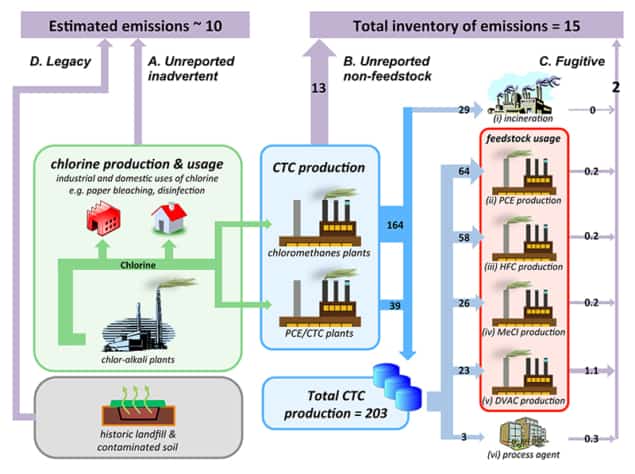
The Montreal Protocol is a spectacular environmental success story. Since 2010 – 21 years after the agreement was signed by 197 parties – levels of stratospheric ozone have stabilized, and there are signs of recovery for the Antarctic ozone hole. But there is still work to be done. One ozone-depleting substance – carbon tetrachloride – has measured emissions far outweighing reported emissions. A new study reveals the likely sources.
As well as depleting ozone, carbon tetrachloride (CCl4 or CTC) is a greenhouse gas and carcinogenic in high concentrations. It plays a major role in destroying ozone, and is practically banned under the Montreal Protocol. Emissions derived from industry estimates suggest that just 3Gg of carbon tetrachloride are released globally every year. But estimates based on ground observations indicate that around 35Gg of carbon tetrachloride is added to the atmosphere every year.
Qing Liang from the NASA Goddard Space Flight Center, US, and colleagues tried to pin down the cause of this discrepancy by calculating the likely emissions from industrial sources and legacy emissions for the year 2014. They gathered data and calculated potential emissions from four different sources of carbon tetrachloride: the production and use of chlorine gas, the production of chloromethanes (used to make numerous industrial solvents for dry cleaning, paint stripping etc.), contained usages of carbon tetrachloride, and historic emissions from contaminated landfill and soil.
Chlorine is commonly used for paper bleaching and disinfection, and is usually produced in chlor-alkali plants. However, during the production process hydrocarbons can be chlorinated relatively easily, inadvertently releasing carbon tetrachloride. Liang and colleagues estimate that this, together with legacy emissions, could be responsible for up to 10Gg per year.
Chloromethanes are present in numerous industrial solvents and reagents, such as those for dry-cleaning and paint stripping. They are also a precursor in Teflon production. This process produces carbon tetrachloride that is supposed to be disposed of, usually via incineration, so its emissions of the compound should be negligible.
However, Liang and colleagues estimate that carbon tetrachloride emissions during production of the substance itself could be as high as 15Gg per year. “Because CTC evaporates easily emissions can easily occur during CTC production, unless tightly contained,” said Liang. “While deliberate production, usage, and destruction of CTC are accurately monitored and reported, unintentional CTC leakage to the atmosphere occurs.”
Finally, those carbon tetrachloride emissions from historic industrial sites and landfill. Liang and colleagues estimate that this contributes a few Gg per year. In total the new estimates suggest that these industrial and legacy sources release around 25Gg of carbon tetrachloride to the atmosphere each year; a figure considerably larger than the reported 3Gg, but still 10Gg short of the 35Gg per year estimated by satellite observations.
“If the current CTC emissions continue into the future, it will lead to an extra 5% increase in atmospheric chlorine and bromine abundance between 2050–2100 and a corresponding ~3% decrease in Antarctic total column ozone,” said Liang, whose findings are published in Environmental Research Letters (ERL). The scientists intend to try and gather more detailed data from under-reported industrial regions.



